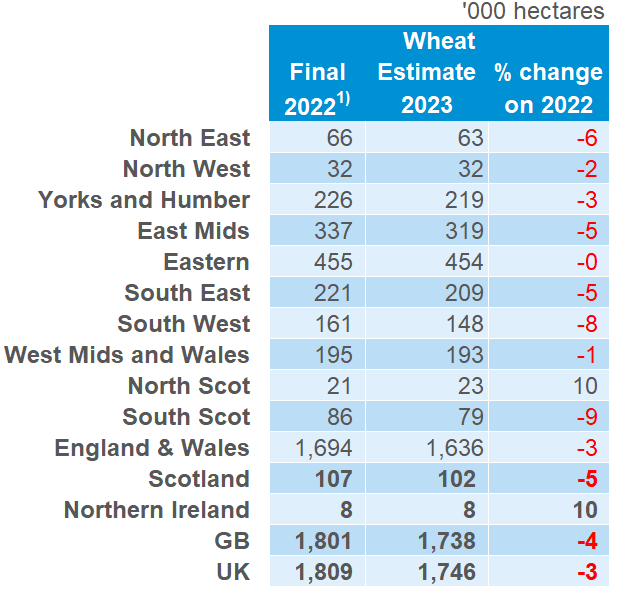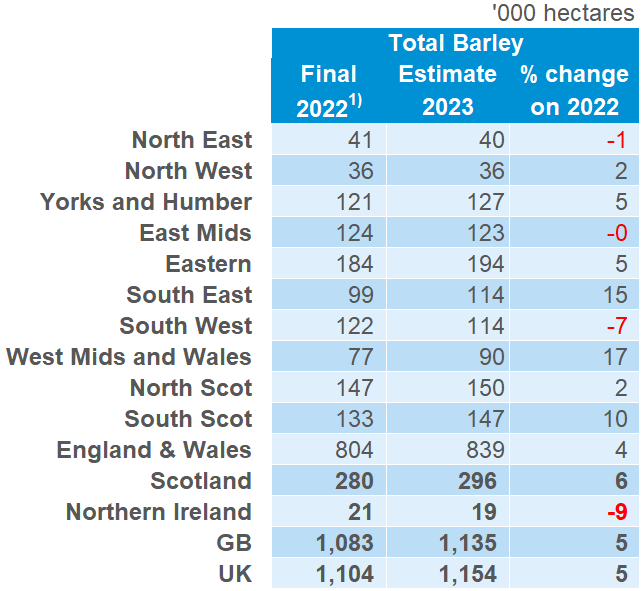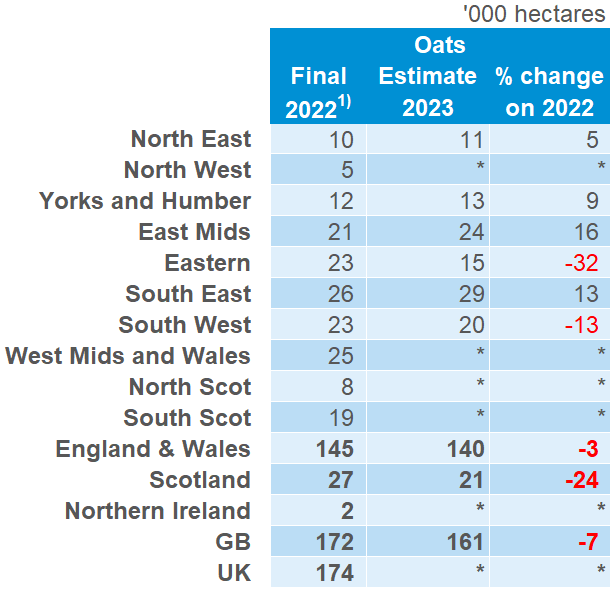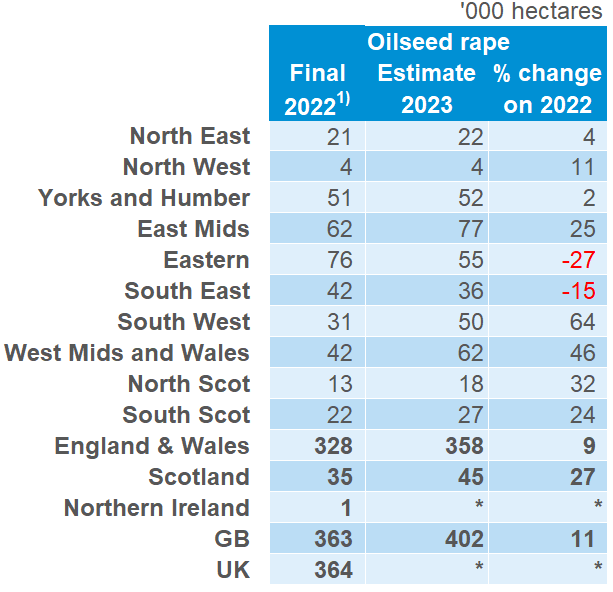- Home
- Markets and prices
- Cereals and oilseeds markets - Supply and demand - Planting and Variety Survey
Planting and Variety Survey
The Planting and Variety Survey provides the UK planted area estimates for the upcoming harvest. Broken down not only into crops but also by UK flour miller group and malting or non-malting approved barley.
Submissions for the 2024 Planting and Variety survey are now open, please click the button below or click here to learn more about the survey.
Overview
This year’s Planting and Variety Survey provides planted area estimates for the UK with a regional breakdown.
- In 2023 the total UK wheat area is estimated at 1,746 Kha, 3% down from 2022.
- The total UK barley area for harvest 2023 is estimated at 1,154Kha, up 5% on the year. The GB spring barley area is estimated at 702 Kha, up 7% year-on-year, while the GB winter barley area is estimated to be 2% higher at 434 Kha.
- The GB oat area is estimated at 161 Kha, this is 7% down year-on-year.
- The GB oilseed rape (OSR) area is estimated at 402 Kha, this is 11% higher than 2022 levels.
- For harvest 2023 KWS Extase is the most popular wheat variety with 17% of the total GB wheat area. For barley, Laureate is the most popular variety, accounting for 32% of the total GB barley area.
Wheat
The UK wheat area for harvest 2023 is estimated to decreased by 3% year-on-year to 1,746 Kha.
Nationally the UK wheat area has largely been replaced with more barley and oilseed rape (OSR) for 2023.
The region driving the reduction in area is the East Midlands (-5%), where the wheat area is estimated at 319 Kha, down 18 kha from 2022, with the area replaced with an increase in OSR.
Further driving the reduction in area is the South East (-5%) and South West (-8%), where the total reduction of these two regions combined account for 25 Kha. For the South East this has largely been replaced with increases of both winter (+13%) and spring (+19%) barley. However, for the South West this has been driven by an increase in OSR (+64%).
In Yorkshire and the Humber the wheat area is estimated to be 219 Kha, down by 8 Kha from 2022. Excluding the 2020 area due to the Autumn wash out, this will be the smallest wheat area in the region since 2013.
In terms of varieties, estimated areas for Group 1 and 2 varieties account for 44% of the 2023 GB wheat area.
KWS Extase is the most popular variety at 17% of total area. However, KWS Dawsum is only slightly behind at 11% of total area.

Barley
The total UK barley area is estimated to increase for both winter and spring barley, to be up 5% year-on-year at 1,154 Kha.
Overall, 57% of the total GB barley area is malting barley varieties, with full approval from the Institute of Brewing & Distilling.
Laureate is the most popular variety and accounts for 32% of total area, while RGT Planet is second accounting for 9% of total area.
Winter Barley
The overall GB winter barley area for 2023 has increased by 2% year-on-year to 434 Kha.
Driving the increase in winter barley area are the Eastern (+7%) and South East (+19%) regions of GB, who collectively are estimated to grow an extra 14 Kha in area year-on-year.
Regional breakdowns show that, more winter barley has been sown at the expense of OSR in the Eastern region, and at the expense of wheat in the South East region.
Spring Barley
The GB spring barley area is estimated at 702 Kha, up 7% on 2022, which was the lowest spring barley area since 2015.
Every region within GB has increased in spring barley area apart from the North West, South West and East Midlands.
Driving much of the increase in spring barley area is the year-on-year increase in the West Midlands and Wales (+47%), also the increase in South Scotland (+11%).
Further increases were also noted in the Eastern and South East region from reductions in OSR area. This may have been further exacerbated following OSR crop losses, as both areas have increased when compared to last autumns Early Bird Survey.

Oats
The area for oats in GB is estimated at 161 Kha, down 7% year-on-year. The GB oat area continues to contract from the highs captured in 2020 & 2021. However, the area does remain historically high, but is the lowest since 2017.
Driving much of this area loss is the Eastern region, which is estimated at 15 Kha, down 7 Kha from 2022.

Oilseed Rape
The GB area for OSR is estimated at 402 Kha, up 11% year-on-year. There is a large increase in the OSR area as prices rallied in spring last year. In spring 2022 when plantings intentions were being decided, spot delivered OSR prices were at over £800.00/t. This was due to the war in Ukraine which set a bullish spur into commodity markets.
Every region in GB has recorded an increase in area apart from the Eastern (-27%) and South East (-15%). Both respective regions are lower in comparison to the Early Bird Survey. Crop loss for this growing season has been variable nationally. However, there are reports of losses in these two respective regions, which could give insight into why their spring barley areas have increased.
Driving the large increase in OSR area has been year-on-year area rises in the East Midlands (+25%), the South West (+64%) and West Midlands & Wales (+46%), collectively these areas have increased by 54 Kha year-on-year. For the East Midlands and South West these increases have been at the expense of wheat.

Additional Information
- The survey had 618 valid responses. Growers were asked to submit intended harvest areas and the area harvested last year. Data for this survey was collected during the months of April to July 2023.
- 1) Final 2022 Defra data.
- 2) Defra only provide oilseed rape winter crop areas for the English regions. Therefore, to enable a consistent comparison, the English spring oilseed rape area from harvest 2022 has been apportioned in the same ratio as the winter crops and included in the regional totals for harvest 2022.
- 3) Scotland crop areas are based on areas submitted on subsidy claims and excludes a relatively small area for farmers not claiming in 2022.
- 4) Due to a low response rate, West Midlands and Wales have been combined for all crops.
- * Insufficient sample to produce robust figure.
- Regional breakdowns are based on the Nomenclature of Territorial Units for Statistics (NUTS) regions. North Scotland consists of the Highlands & Islands and the North East regions. South Scotland consist of Southern, Eastern and West Central regions.
- Please note that totals may not agree due to rounding and breakdown at regional levels are based on smaller sample sizes than at the national level and are therefore subject to more uncertainty.
Historic Spring Planting and Variety Survey results
While AHDB seeks to ensure that the information contained on this webpage is accurate at the time of publication, no warranty is given in respect of the information and data provided. You are responsible for how you use the information. To the maximum extent permitted by law, AHDB accepts no liability for loss, damage or injury howsoever caused or suffered (including that caused by negligence) directly or indirectly in relation to the information or data provided in this publication.
All intellectual property rights in the information and data on this webpage belong to or are licensed by AHDB. You are authorised to use such information for your internal business purposes only and you must not provide this information to any other third parties, including further publication of the information, or for commercial gain in any way whatsoever without the prior written permission of AHDB for each third party disclosure, publication or commercial arrangement. For more information, please see our Terms of Use and Privacy Notice or contact the Director of Corporate Affairs at info@ahdb.org.uk © Agriculture and Horticulture Development Board. All rights reserved.

